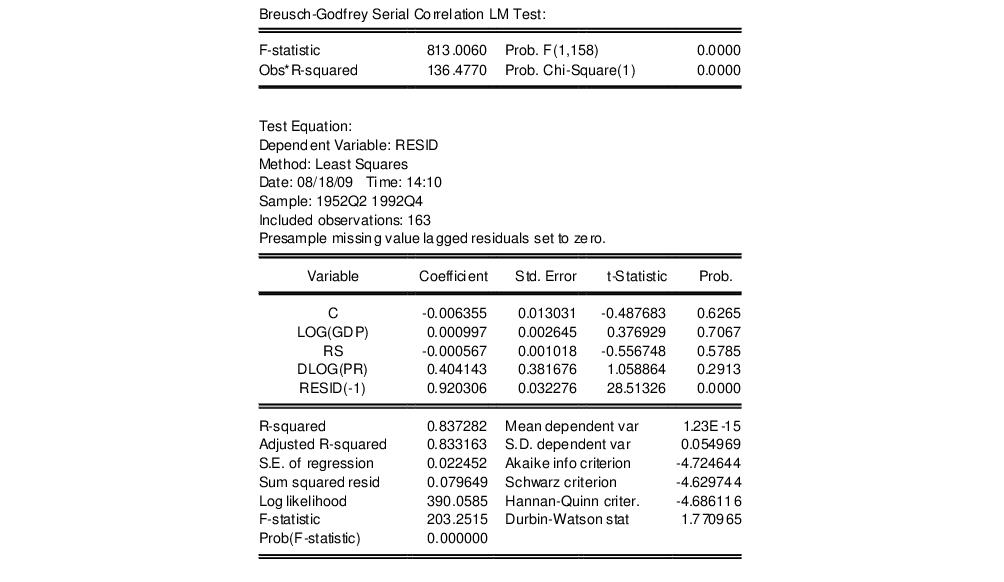-
Breusch Godfrey Serial Correlation Lm Test Sas카테고리 없음 2020. 2. 21. 17:21
In, the Breusch–Godfrey test, named after and, is used to assess the validity of some of the modelling assumptions inherent in applying models to observed data series. In particular, it for the presence of that has not been included in a proposed model structure and which, if present, would mean that incorrect conclusions would be drawn from other tests, or that sub-optimal estimates of model parameters are obtained if it is not taken into account. The regression models to which the test can be applied include cases where lagged values of the are used as in the model's representation for later observations. This type of structure is common in.Because the test is based on the idea of, it is sometimes referred to as LM test for serial correlation.A similar assessment can be also carried out with the and the. Breusch, T.
'Testing for Autocorrelation in Dynamic Linear Models'. Australian Economic Papers. 17: 334–355. Godfrey, L. 'Testing Against General Autoregressive and Moving Average Error Models when the Regressors Include Lagged Dependent Variables'. 46: 1293–1301. Asteriou, Dimitrios; Hall, Stephen G.
Serial Correlation Test In R
Applied Econometrics (Second ed.). New York: Palgrave Macmillan.
Pp. 159–61. CRAN. Kleiber, Christian; Zeileis, Achim (2008). Applied Econometrics with R. New York: Springer. Pp. 104–106. (PDF).
Stata Manual. Baum, Christopher F. An Introduction to Modern Econometrics Using Stata. Pp. 155–158. Breusch-Godfrey test in Python 2014-02-28 at theFurther reading. Godfrey, L. Misspecification Tests in Econometrics.
Cambridge, UK: Cambridge. Godfrey, L. 'Misspecification Tests and Their Uses in Econometrics'. Journal of Statistical Planning and Inference.
49 (2): 241–260.; Lahiri, Kajal (2009). Introduction to Econometrics (Fourth ed.). Chichester: Wiley.
The RMSE is the square root of the variance of the residuals. It indicates the absolute fit of the model to the data–how close the observed data points are to the model’s predicted values. Whereas R-squared is a relative measure of fit, RMSE is an absolute measure of fit. Lower values of RMSE indicate better fit.2. Linear Relationship between Dependent and Independent VariablesI. Scatter plot of independent variable vs.
Dependent variableods graphics on;proc reg data=reg.crime;model crime=pctmetro poverty single / partial;run;quit;ods graphics off. Another way of thinking of this is that the variability in values for your independent variables is the same at all values of the dependent variable.I.
Plot Residuals by Predicted valuesproc reg data= reg.crime;model crime = poverty single;plot r.p.;run;quit;II. White, Pagan and Lagrange multiplier (LM) TestThe White test tests the null hypothesis that the variance of the residuals is homogenous (equal). We use the / spec option on the model statement to obtain the White test.If the p-value of white test is greater than.05, the homogenity of variance of residual has been met.

With PROC MODEL (White and Pagan Test, No CLASS statement for categorical variables)proc model data= reg.crime;parms a1 b1 b2;crime = a1 + b1.poverty + b2.single;fit crime / white pagan=(1 poverty single)out=resid1 outresid;run;quit;If the p-value of white test and Breusch-Pagan test is greater than.05, the homogenity of variance of residual has been met.Consequences of Heteroscedasticity. The regression prediction remains unbiased and consistent but inefficient. It is inefficient because the estimators are no longer the Best Linear Unbiased Estimators (BLUE). The hypothesis tests (t-test and F-test) are no longer valid. MulticollinearityMutlicollinearity means there is a high correlation between independent variables. Independence of error terms - No AutocorrelationIt states that the errors associated with one observation are not correlated with the errors of any other observation. It is a problem when you use time series data.
Suppose you have collected data from labors in eight different districts. It is likely that the labors within each district will tend to be more like one another that labors from different districts, that is, their errors are not independent.proc reg data = reg.crime;model crime = poverty single / dw;run;PROC REG tests for first-order autocorrelations using the Durbin-Watson coefficient (DW). The null hypothesis is no autocorrelation. A DW value between 1.5 and 2.5 confirms the absence of first-order autocorrelation. If DW value less than 1.5, it indicates positive autocorrelation. If DW value greater than 2.5, it indicates negative autocorrelationAutocorrelation inflates significance results of coefficients by underestimating the standard errors of the coefficients.
Hypothesis testing will therefore lead to incorrect conclusions.Another alternative test: Lagrange Multiplier TestIt can be used for more than one order of auto correlation. It consists of several steps. First, regress Y on Xs to get residuals. Compute lag value of residuals up to pth order. Replace missing values for lagged residuals with zeros.

Durbin Watson Test
Rerun regression model including lagged residual variable as an independent variable.proc autoreg data = reg.crime;model crime = poverty single / dwprob godfrey;run. The RMSE for your training and your test sets should be very similar if you have built a good model. If the RMSE for the test set is much higher than that of the training set, it is likely that you've badly over fit the data, i.e. You've created a model that tests well in sample, but has little predictive value when tested out of sample.Important Point 3: Transformation RulesThe specific transformation used depends on the extent of the deviation from normality.1.
Breusch Godfrey Test Sas
If the distribution differs moderately from normality, a square root transformation is often the best.2. A log transformation is usually best if the data are more substantially non-normal.3. An inverse transformation should be tried for severely non-normal data.4. If nothing can be done to 'normalize' the variable, then you might want to dichotomize (2 categories) the variable.